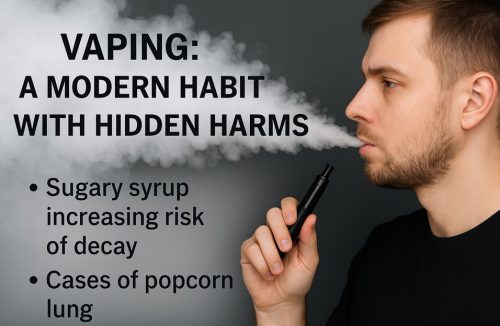A Call for Awareness

Vaping: A Modern Habit with Hidden Harms
In recent years, vaping has been marketed as a “safer alternative” to traditional cigarette smoking. Glossy packaging, fruity flavors, and sleek devices have made e-cigarettes particularly attractive to younger generations. However, mounting evidence suggests that vaping is far from harmless. In fact, in certain ways, it may be just as damaging, or even more damaging, than smoking.
Sugary Syrups and Oral Health
One of the overlooked dangers of vaping lies in its liquid formulations. The majority of e-liquids contain sweetened flavoring agents, essentially sugary syrups that coat the mouth and teeth when inhaled. Unlike food and drink, which are typically cleared from the oral cavity with saliva and swallowing, the aerosolised particles from vaping linger on the teeth, tongue, and gums.
These sugary residues provide a ready food source for cavity-causing bacteria. Over time, this increases the risk of tooth decay, enamel erosion, and gum disease. In addition, the acidic compounds present in many e-liquids can weaken enamel further, creating a perfect storm for dental damage.
Vaping and “Popcorn Lung”
Perhaps one of the most alarming risks associated with vaping is a condition known as bronchiolitis obliterans, more commonly referred to as “popcorn lung.” This irreversible lung disease is caused by scarring of the tiny air sacs in the lungs, leading to coughing, wheezing, and shortness of breath.
The culprit? Diacetyl, a chemical once widely used in microwave popcorn flavoring. While banned from many food products, diacetyl has been detected in certain vape liquids. When inhaled, even in small amounts, it can cause severe and permanent damage to lung tissue. Unlike traditional smoking, where the risks are long-term and cumulative, popcorn lung can develop more rapidly in vulnerable individuals exposed through vaping.
As healthcare professionals and members of the public, we must be wary of trends that promise safety while masking hidden harm. The long-term effects of vaping are still being studied, but the evidence we already have points to significant risks. Whether through increased dental decay, lung damage, or the perpetuation of nicotine addiction, vaping is proving to be more than just a “bad habit.” It is a health hazard.
Quitting both smoking and vaping remains the best option for safeguarding health. Just as the harms of cigarettes took decades to come fully to light, so too will the true dangers of vaping emerge over time. The safest path is not to switch from one to the other, but to break free from both.

